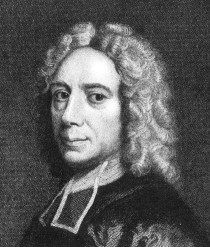
Isaac Watts, the English hymn-writer, theologian and logician, was born in Southampton in July 1674, and educated at King Edward VI School, where he learned Latin, Greek and Hebrew. Because his family were Non-Conformists, he did not attend Oxford or Cambridge University, but instead was sent to the Dissenting Academy in Stoke Newington, London, until 1694. After a two-year period of writing, in which he probably penned his educational works on Logic and Geography and Astronomy, as well as a number of hymns, in 1696 he became tutor and chaplain to the family of Sir John Hartopp of Leicestershire.
In 1699 Watts was chosen as assistant to Dr. Isaac Chauncy (1632-1712), pastor of Mark Lane Independent (i.e. Congregational) Chapel, London, whom he succeeded as sole pastor in 1702. The state of his health, which he had injured by overwork, led to the appointment of an assistant in 1703. In 1704 the congregation removed to Pinner’s Hall, and in 1708 they built a new meeting-house in Bury Street. Watts held the position of pastor for 46 years, although he was not able to preach regularly owing to grievous bodily affliction. His nervous system was in a shattered condition, and this entailed insomnia. Humanly speaking, he could not have lived but for the unremitting and loving care bestowed upon him by Lady Abney and her daughter.
In 1712 he had been invited to spend a week at the home of the wealthy Dissenter Sir Thomas Abney in Hertfordshire. He ended up staying there for the rest of his life, devoting himself to writing. In his own words, as spoken to the Countess of Huntingdon, he expressed his feelings: ‘I came to the house of my good friend, Sir Thomas Abney, intending to spend a single week beneath his roof, and I have extended my visit to thirty years.’ ‘I consider your visit, my dear Sir, as the shortest my family ever received,’ replied Lady Abney.
Sir Thomas died eight years after Watts became a resident under his roof, but Lady Abney survived the poet for some twelve months. Watts died in Stoke Newington in November, 1748, and was buried in Bunhill Fields, where a tombstone was erected to his memory by Sir John Hartopp and Lady Abney. A prolific and popular hymn-writer, he is recognised as the ‘Father of English Hymnody’, credited with some 750 hymns. His book A Guide to Prayer is published by the Trust.
